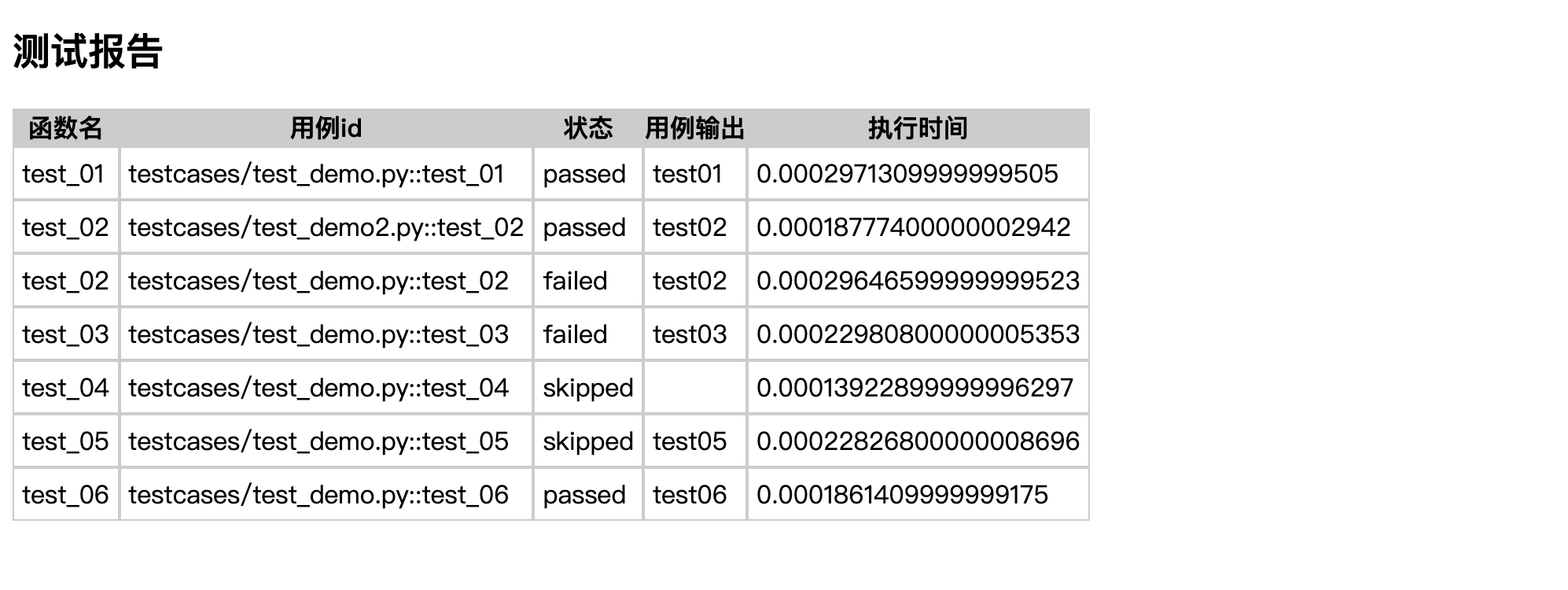使用Pytest测试框架生成测试报告最常用的便是使用pytest-html和allure-pytest两款插件了。
pytest-html简单(支持单html测试报告),allure-pytest则漂亮而强大。
当然想要使用自定义模板生成测试报告也非常简单,简单实现步骤如下:
- 介入Pytest运行流程,运行后自动生成HTML测试报告:使用Hooks方法
- 拿到运行结果统计数据:钩子方法pytest_terminal_summary的terminalreporter对象的stats属性中
- 渲染HTML报告模板生成测试报告:使用Jinjia2
经研究,Hooks方法pytest_terminal_summary及运行完毕生成命令行总结中包含的terminalreporter对象的stats属性中包含我们需要的测试结果统计。
使用Pytest的对象自省(对象.__dict__或dir(对象))我们可以很方便的查看对象有哪些属性,在conftest.py文件中编写钩子函数如下:
# file: conftest.py
def pytest_terminal_summary(terminalreporter, exitstatus, config):
from pprint import pprint
pprint(terminalreporter.__dict__) # Python自省,输出terminalreporter对象的属性字典
编写一些实例用例,运行后屏幕输出的terminalreporter对象相关属性如下:
{'_already_displayed_warnings': None,
'_collect_report_last_write': 1629647274.594309,
'_keyboardinterrupt_memo': None,
'_known_types': ['failed',
'passed',
'skipped',
'deselected',
'xfailed',
'xpassed',
'warnings',
'error'],
'_main_color': 'red',
'_numcollected': 7,
'_progress_nodeids_reported': {'testcases/test_demo.py::test_01',
'testcases/test_demo.py::test_02',
'testcases/test_demo.py::test_03',
'testcases/test_demo.py::test_04',
'testcases/test_demo.py::test_05',
'testcases/test_demo.py::test_06',
'testcases/test_demo2.py::test_02'},
'_screen_width': 155,
'_session': <Session pythonProject1 exitstatus=<ExitCode.TESTS_FAILED: 1> testsfailed=2 testscollected=7>,
'_sessionstarttime': 1629647274.580377,
'_show_progress_info': 'progress',
'_showfspath': None,
'_tests_ran': True,
'_tw': <_pytest._io.terminalwriter.TerminalWriter object at 0x10766ebb0>,
'config': <_pytest.config.Config object at 0x106239610>,
'currentfspath': None,
'hasmarkup': True,
'isatty': True,
'reportchars': 'wfE',
'startdir': local('/Users/superhin/项目/pythonProject1'),
'startpath': PosixPath('/Users/superhin/项目/pythonProject1'),
'stats': {'': [<TestReport 'testcases/test_demo.py::test_01' when='setup' outcome='passed'>,
<TestReport 'testcases/test_demo.py::test_01' when='teardown' outcome='passed'>,
<TestReport 'testcases/test_demo.py::test_02' when='setup' outcome='passed'>,
<TestReport 'testcases/test_demo.py::test_02' when='teardown' outcome='passed'>,
<TestReport 'testcases/test_demo.py::test_03' when='setup' outcome='passed'>,
<TestReport 'testcases/test_demo.py::test_03' when='teardown' outcome='passed'>,
<TestReport 'testcases/test_demo.py::test_04' when='teardown' outcome='passed'>,
<TestReport 'testcases/test_demo.py::test_05' when='setup' outcome='passed'>,
<TestReport 'testcases/test_demo.py::test_05' when='teardown' outcome='passed'>,
<TestReport 'testcases/test_demo.py::test_06' when='setup' outcome='passed'>,
<TestReport 'testcases/test_demo.py::test_06' when='teardown' outcome='passed'>,
<TestReport 'testcases/test_demo2.py::test_02' when='setup' outcome='passed'>,
<TestReport 'testcases/test_demo2.py::test_02' when='teardown' outcome='passed'>],
'failed': [<TestReport 'testcases/test_demo.py::test_02' when='call' outcome='failed'>,
<TestReport 'testcases/test_demo.py::test_03' when='call' outcome='failed'>],
'passed': [<TestReport 'testcases/test_demo.py::test_01' when='call' outcome='passed'>,
<TestReport 'testcases/test_demo2.py::test_02' when='call' outcome='passed'>],
'skipped': [<TestReport 'testcases/test_demo.py::test_04' when='setup' outcome='skipped'>],
'xfailed': [<TestReport 'testcases/test_demo.py::test_05' when='call' outcome='skipped'>],
'xpassed': [<TestReport 'testcases/test_demo.py::test_06' when='call' outcome='passed'>]}}
可以看到stats属性为字典格式,其中包含了setup/teardown状态,以及各种状态(passed,failed,skipped,xfailed,xpassed)等用例结果(TestReport)列表。
我进一步打印一个TestReport对向
# file: conftest.py
def pytest_terminal_summary(terminalreporter, exitstatus, config):
from pprint import pprint
# pprint(terminalreporter.__dict__) # Python自省,输出terminalreporter对象的属性字典
pprint(terminalreporter.stats['passed'][0].__dict__) # 第一个通过用例的TestReport对象属性
打印结果如下:
{'duration': 0.00029346700000010273,
'extra': [],
'keywords': {'pythonProject1': 1, 'test_01': 1, 'testcases/test_demo.py': 1},
'location': ('testcases/test_demo.py', 11, 'test_01'),
'longrepr': None,
'nodeid': 'testcases/test_demo.py::test_01',
'outcome': 'passed',
'sections': [('Captured stdout call', 'test01
')],
'user_properties': [],
'when': 'call'}
我们自己定义报告模板,使用Jinjia2,将stats属性中的统计数据渲染生成自定义报告,完整代码如下:
Jinja2官方使用文档参考:http://doc.yonyoucloud.com/doc/jinja2-docs-cn/index.html
# file: conftest.py
from jinja2 import Template
html_tpl = '''<!DOCTYPE html>
<html lang="en">
<head>
<meta charset="UTF-8">
<title>{{title}}</title>
<style>
table {border-spacing: 0;}
th {background-color: #ccc}
td {padding: 5px; border: 1px solid #ccc;}
</style>
</head>
<body>
<h2>{{title}}</h2>
<table>
<tr> <th>函数名</th> <th>用例id</th> <th>状态</td> <th>用例输出</th> <th>执行时间</th> </tr>
{% for item in results %}
<tr>
<td>{{item.location[2]}}</td>
<td>{{item.nodeid}}</td>
<td>{{item.outcome.strip()}}</td>
<td>{% if item.sections %}{{item.sections[0][1].strip()}}{% endif %}</td>
<td>{{item.duration}}</td>
</tr>
{% endfor %}
</table>
</body>
</html>'''
def pytest_terminal_summary(terminalreporter, exitstatus, config):
results = []
for status in ['passed', 'failed', 'skipped', 'xfailed', 'xpassed']:
if status in terminalreporter.stats:
results.extend(terminalreporter.stats[status])
html = Template(html_tpl).render(title='测试报告', results=results)
with open('report.html', 'w', encoding='utf-8') as f:
f.write(html)
在命令行运行pytest生成的测试报告report.html示例如下
